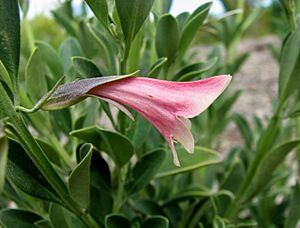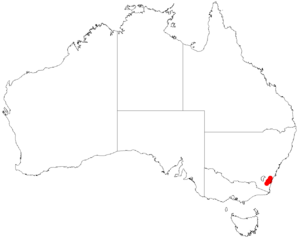Prostanthera porcata facts for kids
Quick facts for kids Prostanthera porcata |
|
|---|---|
 |
|
| In Royal Botanic Gardens, Cranbourne | |
| Scientific classification | |
| Genus: |
Prostanthera
|
| Species: |
porcata
|
 |
|
| Occurrence data from AVH | |
Prostanthera porcata is a special kind of flowering plant. It belongs to the Lamiaceae family, which includes many mint plants. This plant is only found in one specific area: the Budawang Range in south-eastern New South Wales, Australia. It's a small, upright shrub with smooth branches. Its flowers are usually deep pink, or sometimes a mix of pink and cream.
What it Looks Like
Prostanthera porcata is an upright shrub. It usually grows to be about 1.5 to 2 meters (5 to 6.5 feet) tall. Its branches have four ridges and are smooth. They are also covered in tiny glands.
The leaves of this plant are oval-shaped. They are about 22 to 36 millimeters (0.9 to 1.4 inches) long. They are also about 7 to 14 millimeters (0.3 to 0.6 inches) wide. Each leaf has a small stalk, called a petiole, that is 2 to 8 millimeters (0.08 to 0.3 inches) long.
The flowers grow one by one where the leaves meet the stem. Each flower has a small stalk, called a pedicel, that is 4 to 5 millimeters (0.16 to 0.2 inches) long. At the base of the flower stalk are small leaf-like parts called bracteoles. These are 2.8 to 5.6 millimeters (0.11 to 0.22 inches) long.
The outer parts of the flower bud, called sepals, are 12 to 15.5 millimeters (0.47 to 0.61 inches) long. They form a tube that is 8 to 9 millimeters (0.31 to 0.35 inches) long. The sepals also have two lobes that are 5 to 7 millimeters (0.2 to 0.28 inches) long.
The colorful parts of the flower, called petals, are deep pink. Sometimes they are cream-colored, shading to pink on the lobes. The petals are 23 to 27 millimeters (0.9 to 1.1 inches) long. They form a tube that is 15 to 22 millimeters (0.59 to 0.87 inches) long. This plant blooms in the spring.
How it Was Named
This plant was officially described in 1984. A scientist named Barry Conn gave it its formal name. He wrote about it in the Journal of the Adelaide Botanic Gardens. The plant material he used to describe it was collected in Budawang National Park.
Where it Lives
This special mintbush grows in forests. It prefers steep, rocky slopes. You can find it growing with other trees like Eucalyptus agglomerata and E. sieberi. It is only found in the Budawang Range in south-eastern New South Wales.

